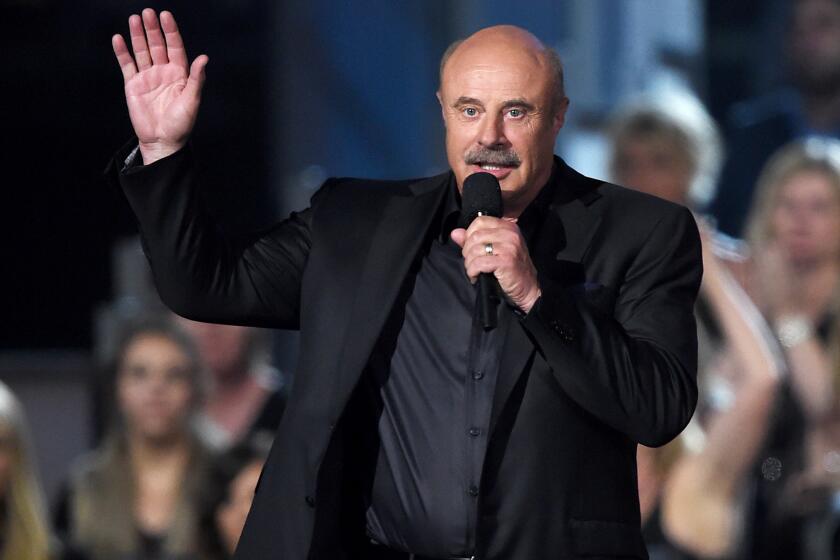Cyrcle’s street artists take their work indoors

- Share via
Best known for its murals and installations on the streets of Los Angeles, the local art collective Cyrcle is transforming a Hollywood gallery into an interactive “hive” — a project that member David Leavitt said is “somewhere between a play, an art show and a video game arcade.”
“Organized Chaos!,” Cyrcle’s second solo gallery show, is designed to work somewhat like pollination: The artists created cubes covered with parts of an image. Patrons are encouraged to take the cubes from a crate and place them into a frame to create their own work. Viewers are the bees, the cubes are pollen, the crate is the flower and the frame is the hive.
It’s just the latest project from Cyrcle. For a YouTube event at the former Howard Hughes hangar last month, its artists created a temporary installation comprising 700 YouTube Playbooks, which provided a 48-foot-by-8-foot wall that they then painted on. As the guests left, they got to take one of the Playbooks — thus a piece of the mural — with them.
PHOTOS: Arts and culture in pictures by The Times
An April Fools’ Day installation outside of LACMA appeared to be a jumble of lines when viewed straight on. But when seen from either side, it turned into a man walking a dog with a stolen Andy Warhol painting under his arm.
One of Cyrcle’s better-known murals, “We Never Die!” on the Branded Arts building in Culver City, will disappear when the building is torn down early next year. The artists were aware the building would be demolished when they made the mural in 2011, but they did it anyway, knowing that part of creating is letting go.
Cyrcle’s Rabï and Leavitt have also created installations in London, Paris and Hong Kong. In their early 20s, they already have a network of collectors and supporters that includes TED prize-winning artist JR and Shepard Fairey.
“Cyrcle is embracing the interactive component in art and engaging the audience in a way that is very different from how the art world usually works,” Fairey said. “They’re bringing a bit of that democracy from the street into the gallery.
“They’ve developed a set of skills across the board but they’re utilizing them within each area in a way that best suits that medium.”
Originally a band of three from L.A. and Seattle, Cyrcle members are self-taught but have backgrounds in design, muralism, spray painting and oil painting. (Devin Liston left to pursue solo work earlier this year.)
The collective has created, among other works, a hand holding a peace sign out of matchsticks for Streetheart, an April 2011 group show that helped raise money for the Red Cross’ Aid for Japan to help earthquake and tsunami victims.
The duo recently completed the 11,000-square-foot mural “Magic Is Real” on the Echo Park recording and rehearsal space Bedrock.LA.
KamranV, co-founder of Bedrock, admired the depth and detail in Cyrcle’s work.
“It’s not just traditional tagging,” KamranV said. “When I look at the mural, it looks as if someone Photoshopped it on there, though it’s actually hand-painted.”
Cyrcle began a campaign that is still running: “Cut It Out” started last year with images such as flower-filled grenades and guns with a pair of scissors and cutting lines around them. They said it was inspired by peaceful protests, encouraging the public to look for progress even in the darkest of situations.
“Someone once called us the motivational speakers of street art,” Rab¿ said.
The current show was built out of space at the Joan Scheckel Filmmaking Lab at 6608 Lexington Ave. in Hollywood. Though it was produced by Fatima Robinson and Rhea Scott, in association with Black Dog Films, the Cyrcle artists curated it themselves.
“Cyrcle is so connected to what’s going on in the world today,” Robinson said. “It’s not just art on the wall. You have to think about how and why these artists came up with the concepts, how their brains work.”
The duo’s work attracted the attention of G. James Daichendt, professor of art history at Azusa Pacific University, who has included Cyrcle in his new book book, “Stay Up! Los Angeles Street Art.”
Daichendt said that while physical interaction in art is not new, it is rare in galleries.
“Most viewers aren’t very engaged; they only look at images for two to three seconds, so anything the artists can do to prolong that is a good thing,” Daichendt said.
MORE
INTERACTIVE: Christopher Hawthorne’s On the Boulevards
TIMELINE: John Cage’s Los Angeles
PHOTOS: Arts and culture in pictures
More to Read
The biggest entertainment stories
Get our big stories about Hollywood, film, television, music, arts, culture and more right in your inbox as soon as they publish.
You may occasionally receive promotional content from the Los Angeles Times.










